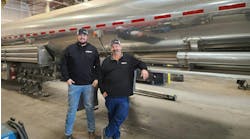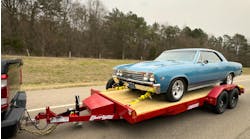House Democrats rolled out a $500 billion draft transportation infrastructure bill on June 3 that includes significant investments in the country’s aging roads and bridges, along with a call to strengthen rear underride guard standards.
The bill, which has been generally lauded by the American Trucking Associations (ATA) and the International Brotherhood of Teamsters, also suspends changes made to drivers’ hours-of-service (HOS) rules and includes additional measures—as well as funding—to address motor carrier safety.
House Committee on Transportation and Infrastructure chairman Peter DeFazio (D-OR) released text of the Investing in a New Vision for the Environment and Surface Transportation in America (INVEST in America) Act, a key component of the Moving Forward Framework that House Democrats released earlier this year.
“The bulk of our nation’s infrastructure—our roads, bridges, public transit and rail systems, the things that hundreds of millions of American families and businesses rely on every single day— is not only badly outdated, in many places it’s downright dangerous and holding our economy back. Yet for decades, Congress has repeatedly ignored the calls for an overhaul and instead simply poured money into short-term patches,” DeFazio said. “The result? We’re still running our economy on an inefficient, 1950s-era system that costs Americans increasingly more time and money while making the transportation sector the nation’s biggest source of carbon pollution.
“That all changes with the INVEST in America Act. The INVEST in America Act is our opportunity to replace the outdated systems of the past with smarter, safer, more resilient infrastructure that fits the economy of the future, creates millions of jobs, supports American manufacturing, and restores US competitiveness.”
Underride provisions
Included in the Motor Carrier Safety portion of the INVEST Act, the underride protection section—incorporating standalone legislation introduced a year ago—calls for new trailer standards to be revised to include rear impact guards that are designed “to prevent passenger compartment intrusion” when a passenger vehicle traveling at 35 miles per hour makes:
- an impact in which the passenger vehicle impacts the center of the rear of the trailer or semi-trailer;
- an impact in which 50% of the width of the passenger vehicle overlaps the rear of the trailer or semi-trailer; and
- an impact in which 30% of the width of the passenger vehicle overlaps the rear of the trailer or semi-trailer.
The bill would require “full compliance” no later than two years after the date on which a final rule is issued.
Additionally, the section calls for additional research on the design and development of rear impact guards that can prevent underride crashes and protect motor vehicle passengers against severe injury at crash speeds of up to 65 miles per hour.
The legislation likewise supports research to better understand the effectiveness of side underride guards and to develop performance standards.
Finally, the bill would require the Secretary of Transportation to establish an Advisory Committee on underride protection “to provide advice and recommendations” to the Secretary on safety regulations to reduce crashes and fatalities involving truck underrides. Committee membership would include two representatives of each of the following:
- Truck and trailer manufacturers
- Motor carriers, including independent owner- operators
- Law enforcement
- Motor vehicle engineers
- Motor vehicle crash investigators
- Truck safety organizations
- The insurance industry
- Emergency medical service providers
- Families of underride crash victims; and
- Labor organizations.
Trailer length standards
Regarding trailers, the Americans for Modern Transportation—a coalition of major shippers and logistics companies—sees the House infrastructure framework as an opportunity to consider “modernizing outdated regulations” and to increase the national twin trailer standard from 28 feet to 33 feet.
“This sensible solution will provide meaningful environmental benefits that policymakers can act on today to make trucking safer, more efficient and less taxing on the roadways,” AMT Executive Director Randy Mullett said. “This solution comes at no cost to the American taxpayer and is already a proven success in 20 states.
“Now is the time to update this close-to 40-year old federal standard as the U.S. Department of Transportation only expects freight volumes to increase. Improvements would benefit consumers, businesses and so many others across our country.”
Motor carrier safety measures
- The authorization of higher grant funding levels for the Motor Carrier Safety Assistance Program, High Priority grants, and CDL Program Implementation grants to assist states in truck and bus safety oversight and enforcement activities, commercial driver licensing, and technology improvements to support those efforts.
- Compliance, Safety, Accountability: The transportation secretary would be required to complete the revisions required by the FAST Act to its carrier oversight and intervention model, to prioritize reinstating the public display of safety data, and to finalize a safety fitness determination rule to rate the safety of carriers.
- A call for a complete rulemaking to require automatic emergency braking systems in newly manufactured commercial motor vehicles.
Driver safety provisions
- A requirement to report on delays with implementation of entry-level driver training.
- Commercial driver licensing requirements to vehicles carrying 9-15 passengers.
- Creating a Truck Leasing Task Force to examine lease-purchase agreements made available to truck drivers and the impacts of captive leases on driver pay.
- A requirement to collect and use data on driver detention to determine the link between detention and safety outcomes.
- A requirement to evaluate the impacts of exemptions before finalizing changes to hours of service rules and establishes stronger reporting requirements for carriers utilizing exemptions.
Industry reaction
“This draft legislation contains significant investment in our country’s roads and bridges. And while we may not agree on every provision therein, this is a real and commendable step on the part of the committee to advance the process in the House and ultimately arrive at a negotiable solution with the Senate,” ATA president and CEO Chris Spear said. “Roads and bridges are not Democrat or Republican. We all drive on them. For the 7.7 million Americans in trucking who do their job each day to move our economy forward, we ask members of Congress to do theirs—and pass a bipartisan infrastructure bill that meets the urgent needs of our economy, our industry and the motoring public.”
The Teamsters have lauded the release of a new House transportation measure, saying the bill is a win for workers and will enhance roadway safety.
“For too long, the needs of professional drivers and others who work in the transportation sector have been ignored by lawmakers,” Teamsters General President Jim Hoffa said. “This legislation will set the nation on the right path by making badly needed infrastructure improvements while ensuring that workers are protected.”
The House Transportation and Infrastructure Committee was scheduled to consider the INVEST in America Act at a committee markup on June 17 (see trailer-bodybuilders.com for the latest developments). The current surface transportation authorization expires Sept 30.









